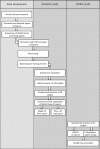Appraising the methodological quality of cadaveric studies: validation of the QUACS scale
- PMID: 25846130
- PMCID: PMC4450944
- DOI: 10.1111/joa.12292
Appraising the methodological quality of cadaveric studies: validation of the QUACS scale
Abstract
Although systematic reviews are conducted in the field of anatomical research, no instruments exist for the assessment of study quality. Thus, our objective was to develop a valid tool that reliably assesses the methodological quality of observational cadaveric studies. The QUACS scale (QUality Appraisal for Cadaveric Studies) was developed using an expert consensus process. It consists of a 13-item checklist addressing the design, conduct and report of cadaveric dissection studies. To evaluate inter-rater reliability, a blinded investigator obtained an initial pool of 120 observational cadaveric studies. Sixty-eight of them were selected randomly according to sample size calculations. Three independent researchers rated each publication by means of the QUACS scale. The reliability of the total score was estimated using the intraclass correlation coefficient (ICC). To assess agreement among individual items, margin-free kappa values were calculated. For construct validity, two experts (an anatomist and an experienced physician) categorized the quality of 15 randomly selected studies as 'excellent' (4 points), 'moderate to good' (3 points), poor to moderate' (2 points) or 'poor' (1 point). Kendall's tau rank correlation was used to compare the expert ratings with the scores on the QUACS scale. An evaluation of feasibility was carried out during the reliability analysis. All three raters recorded the duration of quality appraisal for each article. Means were used to describe average time exposure. The ICC for the total score was 0.87 (95% confidence interval: 0.82-0.92; P < 0.0001). For individual items, margin-free kappa values ranged between 0.56 and 0.96 with an agreement of 69-97% among the three raters. Kendall's tau B coefficient of the association between expert ratings and the results obtained with the QUACS scale was 0.69 (P < 0.01). Required rating time per article was 5.4 ± 1.6 min. The QUACS scale is highly reliable and exhibits strong construct validity. Thus, it can confidently be applied in assessing the methodological quality of observational dissection studies.
Keywords: anatomical study; dissection study; methodological quality.
© 2015 Anatomical Society.
Figures
References
-
- Azer SA, Eizenberg N. Do we need dissection in an integrated problem-based learning medical course? Perceptions of first- and second-year students. Surg Radiol Anat. 2007;29:173–180. - PubMed
-
- Becker I, Woodley SJ, Baxter GD. Gross morphology of the vastus lateralis muscle: an anatomical review. Clin Anat. 2009;22:436–450. - PubMed
-
- den Bekerom MP, Mutsaerts EL, Dijk CN. Evaluation of the integrity of the deltoid ligament in supination external rotation ankle fractures: a systematic review of the literature. Arch Orthop Trauma Surg. 2009;129:227–235. - PubMed
-
- Blitz NM, Eliot DJ. Anatomical aspects of the gastrocnemius aponeurosis and its insertion: a cadaveric study. J Foot Ankle Surg. 2007;46:101–108. - PubMed
Publication types
MeSH terms
LinkOut - more resources
Full Text Sources
Other Literature Sources
Medical



